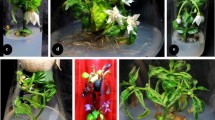Abstract
Capsella bursa-pastoris (L.)Med. is a partially self-pollinating, autogamous plant. The selfing-rate depends on ecological factors. High atmospheric humidity at temperatures over 15 °C and low light intensity, i.e. cloudy and rainy weather, lead to almost exclusive self-pollination, while dry and sunny weather favours outcrossing. At low temperatures (about 4–10 °C) anthesis is prolongated up to five-fold, but allogamy is reduced. Day-length distinctly influences the beginning of flowering.Capsella bursa-pastoris is not a day-neutral plant (as was supposed up to now) but behaves as a quantitative long-day plant.
Similar content being viewed by others
Literaturverzeichnis
Bateman, A. J., 1955: Self-incompatibility systems in Angiosperms. III.Cruciferae. Heredity9, 53–68.
Günthart, A., 1918: Über die Entwicklung und Entwicklungsmechanik der Cruciferenblüte und ihre Funktion unter natürlichen und künstlichen Bedingungen. Beih. Bot. Centralbl.35, 60–170.
Karlin, S., 1968: Equilibrium behaviour of population genetic models with non-random mating. I. Preliminaries and special mating systems. J. App. Prob.5, 231–313.
Knuth, P., 1898: Handbuch der Blütenbiologie. Bd.2 (1). Leipzig: Engelmann.
Kubitzki, K., 1973: Systematik. Fortschritte der Botanik35, 245–288. Berlin-Heidelberg-New York: Springer.
Kugler, H., 1970: Blütenökologie, 2. Aufl. Stuttgart: G. Fischer.
Müller, H., 1873: Die Befruchtung der Blumen durch Insekten und die gegenseitige Anpassung beider. Leipzig.
Rollins, P. C., 1971: Protogyny in theCruciferae and notes onArabis andCaulanthus. Contr. Gray Herb.201, 3–10.
Stäger, R., 1914: Beobachtungen über das Blühen einer Anzahl einheimischer Phanerogamen. Beih. Bot. Centralbl.31, 281–321.
Wöhrmann, K., 1967: Fremdbefruchtungsrate und genotypische „fitness“. Züchter37, 142–146.
—, undLange, P., 1970: Untersuchungen zur Wechselwirkung von Selektion und Selbstungsrate auf das genetische Gleichgewicht unter Berücksichtigung tetraploider Populationen. II. Modell für diploide Populationen. Theor. Appl. Genetics40, 289–295.
Author information
Authors and Affiliations
Additional information
Teil einer Publikationsreihe über die Populationsökologie vonCapsella bursa-pastoris (L.)Med.
Rights and permissions
About this article
Cite this article
Hurka, H., Krauss, R., Reiner, T. et al. Das Blühverhalten vonCapsella bursa-pastoris (Brassicaceae). Pl Syst Evol 125, 87–95 (1976). https://doi.org/10.1007/BF00986774
Received:
Issue Date:
DOI: https://doi.org/10.1007/BF00986774




